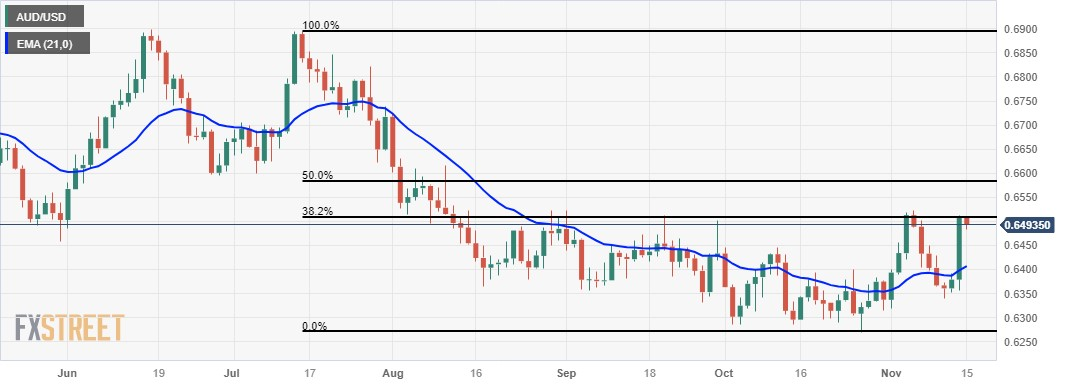Australian Dollar maintains its position around the 0.6500 psychological level.
Australia’s Wage Price Index (Q3) rose by 1.3% as expected and 4.0% annually.
US Dollar faces pressure as US inflation slowed more than anticipated.
China’s Industrial Production exhibited growth at 4.6%; Retail Sales experienced an uptick, reaching 7.6%.
The Australian Dollar (AUD) hovers around the psychological level of 0.6500 on Wednesday. Tuesday’s US CPI data unveiled a more pronounced deceleration in US inflation than initially predicted, leading to a substantial decline in the US Dollar (USD). Consequently, the AUD/USD pair saw a notable increase.
Australia’s Wage Price Index came in on Wednesday, revealing that quarterly labor cost inflation grew 1.3% as expected compared to the previous reading of 0.8%. The year-over-year data showed an increase of 4.0% more than the anticipated 3.9%. The Australian jobs data will be published on Thursday, providing further insights.
Australia’s Westpac Consumer Confidence report indicated a significant drop in consumer sentiment for November. The increasing pressure on data-guided policy adjustments will likely pose a challenge for the Reserve Bank of Australia’s (RBI) board.
China’s Industrial Production (YoY) showed growth at 4.6% in October, a slight increase from the previous 4.5%, contrary to expectations of consistency. Retail Sales year-over-year saw an uptick to 7.6%, surpassing the anticipated 7.0%. These positive indicators in economic activities could offer support for the Australian Dollar (AUD).
The Dollar Index (DXY) recorded a 1.50% decline in the previous session, hitting its lowest point since early September. The Greenback faced additional pressure from increased risk appetite and a downward trend in US Treasury bonds. The US 10-year yield experienced a significant drop to an eight-week low at 4.43%.
Daily Digest Market Movers: Australian Dollar remains below a psychological level amid RBA’s uncertainty over policy rates
Australia’s Westpac Consumer Confidence declined by 2.6% in November, swinging from the previous growth of 2.9%.
RBA Assistant Governor (Economic) Marion Kohler stated that the decline in inflation is expected to be slower than initially anticipated. This is attributed to the persistent high level of domestic demand and robust pressures from labor and other costs. Kohler emphasized the need for a tighter policy to address the challenges posed by elevated inflation.
RBA highlighted the challenges stemming from persistent inflationary pressures and a sluggish domestic economy in its Monetary Policy Statement (MPS) last Friday.
RBA board acknowledges the financial struggles of many households. Budgets are indeed feeling the squeeze. In a twist of economic dynamics, the central bank painted a mixed picture by raising its inflation and GDP growth forecasts.
RBA increased the Official Cash Rate (OCR) from 4.10% to a 12-year high of 4.35%, responding to the latest Monthly Consumer Price Index (YoY) for September, which indicated a notable increase of 5.6% compared to the expected 5.4% growth.
Australia’s TD Securities Inflation (YoY) eased at 5.1% in September from 5.7% prior.
Economists at the National Australia Bank (NAB) anticipate another 25 basis points hike in February following the Q4 inflation data. Additionally, NAB believes rate cuts will unlikely commence until November 2024.
The US-Sino Presidential meeting is on the horizon, and US President Joe Biden aims to rebuild military-to-military connections with China. The much-anticipated face-to-face between Biden and Chinese President Xi Jinping is scheduled for Wednesday during the Asia-Pacific Economic Cooperation summit in San Francisco., marking their first in-person meeting in a year.
The US Consumer Price Index (CPI) for October showed lower readings than expected, with the annual rate slowing from 3.7% to 3.2%, falling below the consensus forecast of 3.3%. The monthly CPI reduced to 0.0% from 0.4%.
The US Core CPI rose by 0.2% below the expectations of 0.3%, and the annual rate decreased to 4.0% from 4.1% prior.
US Monthly Budget Statement reported a deficit of $67B in October, compared to the expected deficit of $65B.
Technical Analysis: Australian Dollar hovers near the 0.6500 major level backed by the 38.2% Fibonacci retracement
The Australian Dollar trades around 0.6490 on Wednesday aligned to the immediate resistance at 0.6500 psychological level, followed by the 38.2% Fibonacci retracement at 0.6508. The 50% retracement is the next upside target at the 0.6582 level. On the downside, the AUD/USD pair could meet the support at the 21-day Exponential Moving Average (EMA) lined up with the major level at 0.6400.
AUD/USD: Daily Chart

Australian Dollar price today
The table below shows the percentage change of Australian Dollar (AUD) against listed major currencies today. Australian Dollar was the strongest against the Japanese Yen.
USD
EUR
GBP
CAD
AUD
JPY
NZD
CHF
USD
0.01%
0.04%
-0.08%
-0.06%
0.12%
-0.27%
0.01%
EUR
-0.02%
0.04%
-0.09%
-0.05%
0.11%
-0.28%
0.00%
GBP
-0.05%
-0.04%
-0.13%
-0.11%
0.07%
-0.31%
-0.04%
CAD
0.08%
0.12%
0.15%
0.07%
0.21%
-0.18%
0.10%
AUD
0.06%
0.07%
0.11%
-0.02%
0.18%
-0.21%
0.07%
JPY
-0.12%
-0.11%
-0.09%
-0.22%
-0.16%
-0.38%
-0.10%
NZD
0.26%
0.27%
0.30%
0.19%
0.21%
0.38%
0.27%
CHF
-0.01%
0.00%
0.03%
-0.09%
-0.05%
0.11%
-0.25%
The heat map shows percentage changes of major currencies against each other. The base currency is picked from the left column, while the quote currency is picked from the top row. For example, if you pick the Euro from the left column and move along the horizontal line to the Japanese Yen, the percentage change displayed in the box will represent EUR (base)/JPY (quote).
RBA FAQs
The Reserve Bank of Australia (RBA) sets interest rates and manages monetary policy for Australia. Decisions are made by a board of governors at 11 meetings a year and ad hoc emergency meetings as required. The RBA’s primary mandate is to maintain price stability, which means an inflation rate of 2-3%, but also “..to contribute to the stability of the currency, full employment, and the economic prosperity and welfare of the Australian people.” Its main tool for achieving this is by raising or lowering interest rates. Relatively high interest rates will strengthen the Australian Dollar (AUD) and vice versa. Other RBA tools include quantitative easing and tightening.
While inflation had always traditionally been thought of as a negative factor for currencies since it lowers the value of money in general, the opposite has actually been the case in modern times with the relaxation of cross-border capital controls. Moderately higher inflation now tends to lead central banks to put up their interest rates, which in turn has the effect of attracting more capital inflows from global investors seeking a lucrative place to keep their money. This increases demand for the local currency, which in the case of Australia is the Aussie Dollar.
Macroeconomic data gauges the health of an economy and can have an impact on the value of its currency. Investors prefer to invest their capital in economies that are safe and growing rather than precarious and shrinking. Greater capital inflows increase the aggregate demand and value of the domestic currency. Classic indicators, such as GDP, Manufacturing and Services PMIs, employment, and consumer sentiment surveys can influence AUD. A strong economy may encourage the Reserve Bank of Australia to put up interest rates, also supporting AUD.
Quantitative Easing (QE) is a tool used in extreme situations when lowering interest rates is not enough to restore the flow of credit in the economy. QE is the process by which the Reserve Bank of Australia (RBA) prints Australian Dollars (AUD) for the purpose of buying assets – usually government or corporate bonds – from financial institutions, thereby providing them with much-needed liquidity. QE usually results in a weaker AUD.
Quantitative tightening (QT) is the reverse of QE. It is undertaken after QE when an economic recovery is underway and inflation starts rising. Whilst in QE the Reserve Bank of Australia (RBA) purchases government and corporate bonds from financial institutions to provide them with liquidity, in QT the RBA stops buying more assets, and stops reinvesting the principal maturing on the bonds it already holds. It would be positive (or bullish) for the Australian Dollar.
Information on these pages contains forward-looking statements that involve risks and uncertainties. Markets and instruments profiled on this page are for informational purposes only and should not in any way come across as a recommendation to buy or sell in these assets. You should do your own thorough research before making any investment decisions. FXStreet does not in any way guarantee that this information is free from mistakes, errors, or material misstatements. It also does not guarantee that this information is of a timely nature. Investing in Open Markets involves a great deal of risk, including the loss of all or a portion of your investment, as well as emotional distress. All risks, losses and costs associated with investing, including total loss of principal, are your responsibility. The views and opinions expressed in this article are those of the authors and do not necessarily reflect the official policy or position of FXStreet nor its advertisers. The author will not be held responsible for information that is found at the end of links posted on this page.
If not otherwise explicitly mentioned in the body of the article, at the time of writing, the author has no position in any stock mentioned in this article and no business relationship with any company mentioned. The author has not received compensation for writing this article, other than from FXStreet.
FXStreet and the author do not provide personalized recommendations. The author makes no representations as to the accuracy, completeness, or suitability of this information. FXStreet and the author will not be liable for any errors, omissions or any losses, injuries or damages arising from this information and its display or use. Errors and omissions excepted.
The author and FXStreet are not registered investment advisors and nothing in this article is intended to be investment advice.
>>> Read full article>>>
Copyright for syndicated content belongs to the linked Source : FXStreet – https://www.fxstreet.com/news/australian-dollar-retreats-from-the-weekly-high-focus-shifts-to-us-ppi-202311150139































